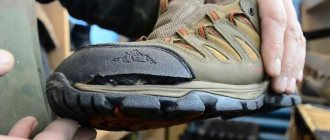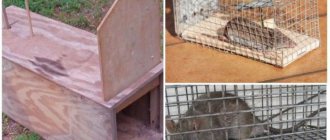Home House and cottage Do it yourself
A do-it-yourself mousetrap made from scrap materials can cope with the task of catching no worse than an industrial product of a similar purpose. In addition, some types of homemade mouse traps do not kill the animal, but only limit its freedom of movement. This moment attracts those who, for whatever reason, do not want to cause the death of an animal and are ready to take on the burden of taking it away from home in order to release it.
Despite their cute appearance, mice can bring a lot of trouble into your home. The smallest is the noise at night created by rodents moving in the cavities of the building. Often, following the smell of food, mice encounter obstacles to their movement in the form of various building structures. If such parts are made of materials that are accessible to the incisors of mice, the animals will damage them.
Mice cause damage not only by eating food. Naturally, a mouse that gets to them is not able to eat everything, but you are unlikely to want to use food that mice have walked through. One of the negative aspects of being around mice is their smell. It is not only unpleasant, but also very persistent.
Mice can cause a fire - these rodents are not averse to tasting the insulation of laid electrical wires, which will cause a short circuit that provokes a fire. In addition, mice are very fond of such a habitat as polystyrene foam, which is easy to gnaw through passages. They often settle in places where polystyrene foam was used as insulation.
Mice are animals that excrete excrement directly as it accumulates in the corresponding organs. Therefore, if mice have entered food storage areas, they will not only gnaw through the packaging, but will also leave behind traces of their visit in the form of excrement, which, naturally, will render the food supplies unusable.
The main danger lurking in mice
Mice are not just unpleasant neighbors, but also quite dangerous animals for human health. These rodents are natural carriers of microbes that cause diseases such as:
- various lichens and fungal diseases;
- salmonellosis;
- toxoplasmosis;
- leptospirosis;
- rabies;
- tularemia;
- pseudotuberculosis;
- rickettsiosis.
In addition, a mouse can become a source of infection with the rabies virus. The mouse itself does not bite a person, but it can manage to bite a cat that is hunting for it and infect it. Subsequently, the already sick cat attacks people.
The negative aspects of the neighborhood of mice are not limited to those listed, but the examples given are enough to take all measures to remove these rodents.
Effective mousetraps are often relevant not only for private houses in rural areas, but also for residents of apartment buildings in the city. With the onset of cold weather, rodents move to where it is warmer, and channels for laid communications and ventilation shafts make it possible to reach the upper floors. If food leftovers are not removed from the apartment at night, the trash can is left open, and there is general unsanitary conditions, there is a high probability of mice appearing.
How to catch a mouse
To check whether there really are mice in the house, you just need to sprinkle a little flour in the “suspicious” areas where the animals supposedly live, and see if traces appear the next morning. Depending on your personal preferences, you can choose different methods of catching mice - from harmless to quite cruel. It should be kept in mind that these rodents rarely leave their nests during the day, so you need to set traps at night.
A mouse is dangerous to humans because it can cause a dangerous infection, especially if it gets into food
Killer Mousetrap
An old, tried and true, but not always effective way to catch a mouse is to use a mousetrap. The latter can be industrially manufactured and vary in design. The principle of operation of such a device is to lure a rodent and then kill or injure it through a special mechanism.
Table: traps that kill rodents
| Traps made of steel and (or) wood | A reliable and proven product that often kills the pest outright. You can use lard, raisins, peanut butter, and smoked meats as bait. |
| Mouse traps | Better and more reliable than similar mechanisms made of wood and metal, due to greater efficiency, less risk of injury to humans, simplified design and versatility. |
| Mousetrap | A simple but not very effective design. The principle of operation is to lure the animal and suffocate it with a steel loop. |
| Electric mousetrap | The principle of operation is based on luring and shocking a rodent with an electric current. A relatively humane tool for killing mice. |
Photo gallery: types of mousetraps
A classic mousetrap consists of a wooden plank and a metal spring.
On sale you can find an improved version of the classic mousetrap
Electric mouse trap electrocutes mice
Humane traps
Not everyone will enjoy killing or maiming a living creature, even a very harmful one. Manufacturers specializing in the production of rat and mouse traps have developed a large number of humane mouse traps that do not harm animals. As a rule, the operating principle of such products is based on luring the animal using bait into a cage (box, container) with an automatically closing door. The caught troublemaker can then be released. It is recommended to do this at least one kilometer from home.
A mouse caught in a cage mousetrap remains alive
Table: traps that do not harm the animal
| Live traps of various types | A very simple but effective type of mouse trap that can be used repeatedly. They are safe for both rodents and people. It is recommended to use chocolate, seeds, bread with sunflower oil as bait. |
| Mousetrap cage | It is hygienic and humane, but less safe for people compared to modern live traps due to the presence of a trigger mechanism. Sometimes false positives may occur. |
Mousetrap or cat
Cats are often cited as the best remedy for mice. However, this is not true. Firstly, as practice shows, the smell of a cat is not a factor for mice that forces them to immediately leave the place where such a mark is present. Secondly, the cat hunts mice only when it is hungry, and, having eaten, stops hunting. There is no strict scientific data on how many mice a cat catches. The only statistically reliable can be considered the recorded count of mice caught by the Scottish cat Towser over the course of twenty-one years. Their number was 28,899 rodents, but if we consider the day, then this is only 4 mice during the cat’s waking period.
The famous Austrian ethologist Konrad Lorenz cites an interesting case in his books. The mousetrap, made from a handy object such as a bucket, caught about two dozen mice overnight. A cat was thrown among the rodents. The pet quickly strangled 4 mice, grabbed one of the victims in its teeth and jumped out of the bucket. Having eaten the prey, the cat did not return to the trap, but calmly went home.
Unlike a live mouse trap, properly made traps are more effective and permanently control rodents.
Traditional methods
Folk methods involve a wide range of devices and methods for destroying or removing mouse brood. While we have already looked at homemade traps, we have not yet studied means that can drive away harmful neighbors.
A mint solution is effective in controlling rodents Source stroy-podskazka.ru Coriander (cilantro) against mice Source autogear.ru
Yellow tansy flowers Source parazitdoma.ru
Peppermint
Peppermint is often used to control mice. This is an accessible, cheap and effective remedy. The aroma of the plant is pleasant to human charm, but intolerable to rodents. The herb can be used in one of 3 ways:
- Place grass in the corners of the room, plant a plant in the local area.
- Brew a strong decoction and spray the areas where mice were spotted.
- Soak rolled cotton balls or disks in the broth and place them in the corners of the room.
Types and Types of Mouse Traps
Broadly speaking, mouse traps can be classified according to their capture methods.
- Mechanical traps.
- Sticky traps.
- Electronic traps.
Various poisoned baits are also used to kill small rodents. The use of such baits has some limitations:
- it is undesirable to use if there is a possibility of poisoned baits being eaten not only by mice, but also by domestic animals;
- allergic reactions may occur in people;
- if the corpse of a poisoned mouse is eaten by a pet (dog, cat), it may be poisoned;
- If a poisoned mouse dies within the house in a hard-to-reach place, for example, under the floor, the smell of decomposition will bring many unpleasant moments.
Unlike poisoned baits, traps do not have the listed negative features.
A piece of paper can help make sure that there are mice in the house. It needs to be crumpled up and placed overnight in front of the hole that could serve as the entrance to the burrow. If in the morning it turns out that the piece of paper has been discarded, it means that uninvited guests have indeed appeared in the house.
Harm from mice
These pests need to be controlled for several reasons. Firstly, many people are afraid of mice, especially housewives. When mice appear, they panic. In addition, there are a number of factors that are decisive. For example:
- Damage to household items. They were called rodents for good reason, since they are capable of chewing objects in the house, regardless of the material they are made of. This could be furniture, electrical wires, children's toys, shoes, etc. They especially love foam. If someone has made a renovation and used polystyrene foam as insulation, then you need to be prepared to receive such pests.
- Possibility of fire. Mice can easily eat the insulation of electrical wires, which can ultimately lead to a short circuit and fire. They can chew the power wires of many electrical appliances, so you need to regularly inspect them to ensure the integrity of the insulation.
- Presence of pathogenic microorganisms. The saliva of rodents can contain various microorganisms that can cause typhoid, cholera, plague or ordinary poisoning. In addition, mice are carriers of fleas, which prefer to feed on human blood.
- Rodents spoil food and water. This happens because mice everywhere leave traces of their vital activity in the form of feces, which are saturated with bacteria and viruses. If an animal drinks water from a cup, it can be hazardous to health.
- Mice leave behind an unpleasant odor. This is a kind of “mouse” smell, which is distinguished by its peculiarity. It is by this that you can determine that there are mice in the house. If it gets absorbed into furniture or some things, it is quite difficult to get rid of it. Some people may experience allergy attacks, which are expressed in the form of vomiting. In any case, this leads to constant discomfort.
Therefore, we can safely say that rodents cause significant harm, depriving a person of peace and comfort.
Advantages of self-made traps
Trade organizations offer many different devices designed for catching small rodents. But self-made traps are still somewhat preferable for a number of reasons:
- Since self-made traps are made from existing materials at hand, they will not require purchasing costs;
- Unlike some types of poisoned baits that cause allergies or have an unpleasant odor, using homemade traps will not require you to leave the house;
- Self-made traps do not pose a danger to small children;
- Possible repeated use without unnecessary costs;
- If it breaks, it's easy to make a new one.
Traps made from cans and buckets
The easiest and most effective traps to make can be made from scrap materials available in almost every household, such as buckets and various jars.
Using glass jars from eaten homemade preparations for the winter, you can make a simple trap. A ½ liter jar is enough. Using chewing gum or other adhesive material, such as a piece of insulating tape, a string with bait attached to it is attached to the bottom of the jar. The length of the string is chosen so that the bait hangs freely in the jar turned upside down, and the rodent needs to pull the string to make it more convenient to eat the treat. The jar is turned over and placed so that it rests with the edge of the upper cut of the vessel on some object that is in a state of unstable equilibrium, for example, on a large diameter coin placed on its edge. The diameter of the coin should be such that the resulting gap gives the rodent the opportunity to freely penetrate under the jar. A mouse that sneaks into the jar takes the bait, begins to pull it towards itself, the balance is disturbed and the coin, and after it the jar falls - the mouse finds itself under the jar and cannot get out on its own.
The disadvantages of such a trap include its disposability, that is, until the mouse is removed from the jar, which will have to be installed again above the bait, no other mice will be caught. The simplest traps made from a bucket and available materials do not have this drawback.
To make the simplest version of such a trap, you only need a bucket and a sheet of paper, the area of which allows you to cover the bucket. Even a newspaper will do. The bucket is covered with paper, in which slits are made radially from the center. Bait is placed in the center, for example, grain is poured. You can also hang the bait over the center, from which the slots radiate radially. They also create an opportunity for mice to climb to the top edge of the bucket by installing a flat bar at an angle (this part of homemade traps is called a “zadnik”). Attracted by the smell of the bait, the mouse climbs the rail and rushes towards the food - under the influence of the weight of the rodent, the paper bends in the slots and the mouse falls into the bucket.
Using a bucket you can make another type of trap. In addition to the bucket you will need:
- ruler or thin wooden strip;
- a piece of wire;
- spoke.
The knitting needle is attached across the ruler and, acting as a support, is placed on the top edge of the bucket. The length of the rack or ruler should be such that one end rests on the edge of the bucket, and the other end hangs above the bottom. The bait is placed at this end. The trap is installed so that the rodent can easily reach the ruler. The second end of the ruler is attached to the edge of the bucket with a thread of such length that the ruler can rotate at an angle of 70 to 85 degrees. Under the weight of the mouse moving towards the bait, the ruler will rotate and the rodent will slide into the bucket. The thread will hold the second end of the ruler, and under the influence of its weight it will return to its original position. If the bait is firmly attached to the ruler, the trap will be ready for use again.
It is easy to make a mouse trap from scrap materials, the principle of which is based on the inability of the mouse to stay on a rotating surface. Metal cans, drink packaging, and plastic bottles can be used as a part to ensure effective operation of the trap. How to make such a trap can be seen in the photo.
The bait is attached to the outside of the jar or bottle, which will rotate under the influence of the rodent's weight and the mouse trying to get to the food will slide into the bucket. If you attach baits in several places opposite each other, so that after turning the bottle one of the baits remains on the upper side, then several mice can get caught in such a trap.
How to make a mousetrap with your own hands from wood
The simplest material for making mousetraps is wood; here you can use any wood waste, blocks and even plywood.
Variants of traps made of wood and metal wire
Trap made of board and wire with a spring
The main advantage of a trap with a spring is that it can be used many times. You can always make several traps and place them along the path of rodents to be sure to get rid of mice.
If you look closely, making such a trap with your own hands is quite simple.
What you need to prepare for work
To make a simple trap we will need:
- block 10×5×15 cm (dimensions can be arbitrary);
- drill;
- thin drill;
- spring;
- thin wire;
- mouse bait.
You can make a spring with your own hands; for this you will need 45 cm of wire with a thickness of 1.5-2.5 mm
Step-by-step instructions for making a trap
Making such a trap is quite simple; step-by-step instructions will help us with this.
- Drill two holes in the end of the block.
- Insert a small piece of wire into them and secure it on the reverse side. A loop should remain on the surface.
- Drill two more holes on the sides and make similar wire loops.
- Secure a metal frame with a spring; a hook or spatula for bait must be fixed on it.
- Attach the hook to the clamp.
One of the schemes for making a reusable mousetrap
When the mouse tries to remove the bait, the latch will work and the spring will pin the rodent to the bar
How to make a mousetrap for several holes from timber
A trap with a large number of cells is much more effective than a conventional trap intended for one rodent. It’s enough to make a few pieces and you can safely leave your home. During the absence of the owners, all the mice will be inside.
The number of holes depends on the size of the bar
What you need for work
To make a trap for several minks, we will need the following materials:
- wooden block 5×5 cm². The length depends on the number of holes;
- metal wire;
- spool of thread.
Master class on making your own mousetraps with several cells
To make a burlap for several minks correctly, let's look at the whole process in more detail.
| Illustration | Description of action |
| On a sanded block, mark the distance of future burrows with a diameter of 3 cm at a distance of 1.5 cm from the edge; the distance between them should be about 1-1.5 cm. | |
| Drill blind holes. | |
| Use a milling cutter to make a cut on the side where the holes are located. | |
| Insert small splinters into the slot between the holes. | |
| Install metal brackets. | |
| Draw a line from the center of each hole and, at a distance of 1 cm to the right and left of it, drill holes with a thin drill in the center of the block. | |
| From the opposite edge, drill holes in the center of each line. | |
| Make springs of 1-2 turns and retaining rings from metal wire. | |
| Insert the springs with rings into the holes. | |
| Tie a thread to each spring, pull it through the holes and fix it at the bottom of the board so that the ring is in the slot. | |
| The thread will be exactly in the center of the hole. | |
| Place bait inside the holes. Trying to get to the food, the mouse will gnaw through the thread and end up trapped in a ring. |
You can watch the whole process in more detail on the video: https://www.youtube.com/watch?v=TwPagOdgxeY
Plastic bottle traps
Perhaps the most popular homemade traps are traps made from plastic bottles. As a rule, bottles with a capacity of one and a half to five liters are used.
The simplest trap is a bottle with bait placed at the bottom.
To increase the effectiveness of the trap, the neck of the bottle is often cut off.
In practice, the homemade mousetrap shown in the photo has proven its effectiveness.
The bottle itself is fixed to the surface with a thread. Trying to reach the bait, the animal makes its way into the bottle and, under the influence of the weight of its body, it tips over - the bottle falls, but it hangs, held by the thread, and the mouse cannot get out of the trap.
It is very easy to make a trap out of a plastic bottle that can trap several mice during the night. The walls of the bottle are lubricated with any vegetable oil, bait is placed on the bottom and the bottle is placed obliquely, ensuring easy access to the neck. A mouse that sneaks into the bottle after the bait will not be able to get out, since the slippery surface with the absence of protrusions on which to cling with its claws will not allow the animal to move upward towards the exit/entrance.
To make such traps, you can use not only plastic, but also glass bottles. For example, they take a champagne bottle, pour unrefined sunflower oil into the vessel and roll the bottle on the table so that the oil is evenly distributed along the walls of the bottle. The rodent, attracted by the smell of oil, enters the bottle through the neck and cannot get out because its paws slide along the oiled glass.
For the mousetrap to work effectively, you should keep it clean and wash it regularly using a solution of ash lye or at least regular soda. Neglecting this light will cause the mousetrap to acquire an unpleasant odor that repels rodents.
An effective trap, which is based on the same principle that fishing gear such as tops are made on, can be made from a one and a half liter plastic bottle. Cut off the top third of the bottle and, turning it over, insert it into the lower part. The parts are fastened together using glue, wire or paper clips. The bait is placed inside such a trap, and the neck itself is lubricated with vegetable oil. The mouse crawls inside for food, but can’t get back out.
A mouse trap can also be made from half a plastic bottle. Having retreated a few centimeters from the bottom, the walls are cut along the line of the circle so that when the resulting sectors are bent, sharp teeth are formed, directed towards the center inward. The bait is placed at the bottom and these teeth will not allow the mouse that has penetrated behind it to get out.
Jar as a trap
Jar as a trap
A glass jar is the most accessible and easiest way to catch a mouse.
To make it you need to take:
- liter jar;
- coin;
- thick wire;
- piece of sausage.
Step-by-step algorithm:
- Measure the wire using a ruler; the length should slightly exceed the diameter of the can opening.
- Put on the sausage, fold the edges.
- Place the wire in the middle of the jar.
- Place the mousetrap with the hole down and lean one side against the wall.
- Place the end of a coin under the edge of the jar. The rodent will climb inside, try to pick the sausage, the coin will fall off, and the mouse will be covered with the jar.
Wooden traps
The simplest wooden trap is an ordinary mousetrap, which is designed on the principle of a spring trap. A metal frame with a spring is attached to a wooden plank. You also need a hook on which to attach the bait, as well as a latch that hooks onto the hook. The moment the mouse tries to pull the bait off the hook, the spring will work and slam it to the board.
You can catch several mice at once using a mink trap, a device sometimes called a hive mousetrap. Tunnels with a diameter of three centimeters and a length of six to seven centimeters are drilled into a wooden block. A loop is made from the wire, with the help of which a noose made of thinner wire is attached to the bar. Holes are also drilled in the block to attach the springs. Charged springs are tied with thick threads and baits are placed in the tunnels. Trying to get the “yummy”, the mouse chews the thread, the noose spring is triggered and the trap holds the rodent.
The schematic diagram of such a mousetrap is shown in the figure.
The Zürner trap has proven itself well in exterminating rodents. The bait is suspended above the point of contact of two rotating bars. Under the weight of a mouse approaching the bait, the bar rotates along its axis at the point of attachment to the wall of the trap, and the animal slides into the box, from where it cannot get out.
DIY mousetrap made of wood
This wooden mousetrap can be made with your own hands in just 15-20 minutes, but this model is the most complex. It is possible to install several traps at once, which will be located on one block.
Dimensions will be given for one trap. If you want to increase their number, then simply lengthen the bar several times.
A block with a cross-section of 5 x 10 cm is drilled to a depth of 8 cm using a ø25 mm feather drill.
Let's call this hole a “mink”. A cut is made along the block, 3-4 mm wide.
Step 3
Three thin holes with a diameter of 2-3 mm are drilled, which should be located perpendicular to the axis of the “mink”. In this case, the first hole is located in the longitudinal cut. The second hole is made approximately in the middle of the length of the “mink”. The third hole is made outside the boundaries of the “mink”.
Step 4
A ring with an eye with a diameter of ≈ 3 cm is made from iron wire. Weave a three-turn spring from elastic steel wire. The free ends of the spring should be 8-10 cm long.
Step 5
Make a three-turn spring from elastic steel wire. The free ends of the spring should be 8-10 cm long. Opposite the eyelet, a strong thread is tied to the ring. For ease of work, thread the free end of the thread into a shoemaker's (gypsy) needle.
Step 6
The thread is sequentially threaded first into the first hole (through the cut). Then from below into the second hole and the free end is fixed with tension by the peg
Please note that the ring should sink into the cut so as not to reduce the clearance of the hole
The spring is inserted at one end into the third hole, and its other end is threaded through the ear of the ring.
Step 8
Several sunflower seeds are poured inside the “mink”. A hand-made wooden mousetrap is ready for use and is in a cocked state.
The principle of its operation is as follows. The mouse crawls into the hole, smelling the smell of seeds. But her way is blocked by a thread that holds the ring tensioned by a spring. The mouse easily chews the thread, and immediately finds itself pressed under the ring.
Electronic mousetrap
This type of mousetrap can be made by anyone with minimal knowledge of electrical engineering. There are 2 types of such mousetraps.
- Mousetrap cage. After a rodent, attracted by the smell of the bait, enters the cage, the trap door slams shut, the contacts located on the wall and the door are connected - the electrical circuit is closed and a signal sounds that the trap has worked.
- Killer mousetraps. In such devices, current is supplied to a metal plate installed at the bottom of the trap, as well as to the parts on which the bait is attached, or to parts that are placed on the path to the bait and which will definitely be touched by the animal making its way to the prey. The current passing through the body of the rodent that has closed the circuit kills it.
Traps with glue
To make such traps, a sheet of cardboard, or plywood, or plastic is smeared with a special glue, which includes rosin, pine resin, bitumen pitch and petroleum jelly. There are also modern synthetic adhesives. You can buy them at hardware stores, or prepare them yourself from the above ingredients. Bait is placed in the center of an area covered with glue, and the mouse rushing towards it becomes tightly glued and subsequently dies either from stress or from dehydration.
Use of snares
To make such a mousetrap you will need:
- cable tie;
- heavy load;
- fishing line;
- clip;
- bait.
The snare is installed as shown in the photo.
A loop is made on the fishing line to which the load is attached, into which the bait is inserted and secured with a paper clip. The mouse, grabbing the bait, pulls it out of the loop, the load ends up in free fall and tightens the snare from the cable tie.
What you will need
- a bucket (the bigger the better) or a tall aquarium
- a piece of board or cardboard (dimensions no less than 5x20 cm)
- bait (grain, crumbs, flakes, etc.)
It is worth noting that for rats it is better to take a deeper container. A DIY bucket mousetrap should also work for her.











